An Artificial Intelligence Approach to Predict Gross Primary Productivity in the Forests of South Korea Using Satellite Remote Sensing Data
Abstract
:1. Introduction
2. Materials and Methods
2.1. Study Site
2.2. Data
2.2.1. Overview
2.2.2. Eddy Covariance Flux Data
2.2.3. Input Data Processing
2.3. Artificial Intelligence Models
2.3.1. Support Vector Machine
2.3.2. Random Forest
2.3.3. Artificial Neural Network
2.3.4. Deep Neural Network
2.4. Validations
3. Results
3.1. GPP Estimation by AI Models
3.2. Seasonal Characteristics of Validation Statistics
3.3. Comparisons with Operative GPP Products
4. Discussions
4.1. Performance of AI Models
4.2. Limitations and Future Work
5. Conclusions
Author Contributions
Funding
Conflicts of Interest
References
- FAOSTAT. Statistical Database of the Food and Agriculture Organization of the United Nations. Available online: http://faostat.fao.org/ (accessed on 31 August 2020).
- Stephenson, N.L.; Das, A.J.; Condit, R.; Russo, S.E.; Baker, P.J.; Beckman, N.G.; Coomes, D.A.; Lines, E.R.; Morris, W.K.; Ruger, N.; et al. Rate of tree carbon accumulation increases continuously with tree size. Nature 2014, 507, 90–93. [Google Scholar] [CrossRef]
- Running, S.W.; Baldocchi, D.D.; Turner, D.P.; Gower, S.T.; Bakwin, P.S.; Hibbard, K.A. A global terrestrial monitoring network integrating tower fluxes, flask sampling, ecosystem modeling and EOS satellite data. Remote Sens. Environ. 1999, 70, 108–127. [Google Scholar] [CrossRef]
- Smith, P.; Lanigan, G.; Kutsch, W.L.; Buchmann, N.; Eugster, W.; Aubinet, M.; Ceschia, E.; Béziat, P.; Yeluripati, J.B.; Osborne, B.; et al. Measurements necessary for assessing the net ecosystem carbon budget of croplands. Agric. Ecosyst. Environ. 2010, 139, 302–315. [Google Scholar] [CrossRef]
- Ogutu, B.O.; Dash, J.; Dawson, T.P. Developing a diagnostic model for estimating terrestrial vegetation gross primary productivity using the photosynthetic quantum yield and Earth Observation data. Glob. Chang. Biol. 2013, 19, 2878–2892. [Google Scholar] [CrossRef] [PubMed]
- Farquhar, G.D.; Sharkey, T.D. Stomatal conductance and photosynthesis. Ann. Rev. Plant Physiol. 1982, 33, 317–345. [Google Scholar] [CrossRef]
- Schulze, E.D. Biological control of the terrestrial carbon sink. Biogeosciences 2006, 3, 147–166. [Google Scholar] [CrossRef] [Green Version]
- Kang, M.; Kim, J.; Kim, H.S.; Thakuri, B.M.; Chun, J.H. On the nighttime correction of CO2 flux measured by eddy covariance over temperate forests in complex terrain. Korean J. Agric. For. Meteorol. 2014, 16, 233–245, (In Korean with English abstract). [Google Scholar] [CrossRef] [Green Version]
- Baldocchi, D.; Falge, E.; Gu, L.; Olson, R.; Hollinger, D.; Running, S.; Anthoni, P.; Bernhofer, C.; Davis, K.; Evans, R.; et al. FLUXNET: A new tool to study the temporal and spatial variability of ecosystem-scale carbon dioxide, water vapor, and energy flux densities. Bull. Am. Meteorol. Soc. 2001, 82, 2415–2434. [Google Scholar] [CrossRef]
- Xiao, X.; Zhang, Q.; Braswell, B.; Urbanski, S.; Boles, S.; Wofsy, S.; Moore, B., III; Ojima, D. Modeling gross primary production of temperate deciduous broadleaf forest using satellite images and climate data. Remote Sens. Environ. 2004, 91, 256–270. [Google Scholar] [CrossRef]
- Baldocchi, D.D. Assessing the eddy covariance technique for evaluating carbon dioxide exchange rates of ecosystems: Past, present and future. Glob. Chang. Biol. 2003, 9, 479–492. [Google Scholar] [CrossRef] [Green Version]
- Reeves, M.C.; Zhao, M.; Running, S.W. Usefulness and limits of MODIS GPP for estimating wheat yield. Int. J. Remote Sens. 2007, 26, 1403–1421. [Google Scholar] [CrossRef]
- Tenhunen, J.D.; Yocum, C.S.; Gates, D.M. Development of a photosynthesis model with an emphasis on ecological applications. Oecologia 1976, 26, 89–100. [Google Scholar] [CrossRef]
- Falge, E.; Graber, W.; Siegwolf, R.; Tenhunen, J.D. A model of the gas exchange response of Picea abies to habitat conditions. Trees 1996, 10, 277–287. [Google Scholar]
- Muraoka, H.; Koizumi, H. Photosynthetic and structural characteristics of canopy and shrub trees in a cool-temperate deciduous broadleaved forest: Implication to the ecosystem carbon gain. Agric. Ecosyst. Environ. 2005, 134, 39–59. [Google Scholar] [CrossRef]
- Schindler, D.E.; Hilborn, R. Prediction, precaution, and policy under global change. Science 2015, 347, 953–954. [Google Scholar] [CrossRef] [PubMed] [Green Version]
- Ye, H.; Beamish, R.J.; Glaser, S.M.; Grant, S.C.H.; Hsieh, C.H.; Richards, L.J.; Schnute, J.T.; Sugihara, G. Equation-free mechanistic ecosystem forecasting using empirical dynamic modeling. Proc. Natl. Acad. Sci. USA 2015, 112, E1569–E1576. [Google Scholar] [CrossRef] [PubMed] [Green Version]
- Dou, X.; Yang, Y.; Luo, J. Estimating forest carbon fluxes using machine learning techniques based on Eddy covariance measurements. Sustainability 2018, 10, 203. [Google Scholar] [CrossRef] [Green Version]
- Stockwell, D.; Modelling, A.P.E. Effects of sample size on accuracy of species distribution models. Ecol. Model. 2002, 148, 1–13. [Google Scholar] [CrossRef]
- Elith, J.; Leathwick, J.R. Species distribution models: Ecological explanation and prediction across space and time. Annu. Rev. Ecol. Evol. Syst. 2009, 40, 415–436. [Google Scholar] [CrossRef]
- Kim, N.S.; Han, D.; Cha, J.Y.; Park, Y.S.; Cho, H.J.; Kwon, H.J.; Cho, Y.C.; Oh, S.H.; Lee, C.S. A detection of novel habitats of Abies koreana by using species distribution models (SDMs) and its application for plant conservation. J. Korea Soc. Environ. Restor. Technol. 2015, 18, 135–149. [Google Scholar] [CrossRef] [Green Version]
- Marrs, J.; Ni-Meister, W. Machine learning techniques for tree species classification using co-registered LiDAR and hyperspectral data. Remote Sens. 2019, 11, 819. [Google Scholar] [CrossRef] [Green Version]
- Tramontana, G.; Ichii, K.; Camps-Valls, G.; Tomelleri, E.; Papale, D. Uncertainty analysis of gross primary production upscaling using random forests, remote sensing and eddy covariance data. Remote Sens. Environ. 2015, 168, 360–373. [Google Scholar] [CrossRef]
- Ichii, K.; Ueyama, M.; Kondo, M.; Saigusa, N.; Kim, J.; Alberto, M.C.; Ardö, J.; Euskirchen, E.S.; Kang, M.; Hirano, T.; et al. New data-driven estimation of terrestrial CO2 fluxes in Asia using a standardized database of eddy covariance measurements, remote sensing data, and support vector regression. J. Geophys. Res. Biogeosci. 2017, 122, 767–795. [Google Scholar] [CrossRef]
- Wang, X.; Yao, Y.; Zhao, S.; Jia, K.; Zhang, X.; Zhang, Y.; Zhang, L.; Xu, J.; Chen, X. MODIS-based estimation of terrestrial latent heat flux over North America using three machine learning algorithms. Remote Sens. 2017, 9, 1326. [Google Scholar] [CrossRef] [Green Version]
- Kim, J.; Lee, D.; Hong, J.; Kang, S.; Kim, S.J.; Moon, S.K.; Lim, J.H.; Son, Y.; Lee, J.; Kim, S.; et al. HydroKorea and CarboKorea: Cross-scale studies of ecohydrology and biogeochemistry in a heterogeneous and complex forest catchment of Korea. Ecol. Res. 2006, 21, 881–889. [Google Scholar] [CrossRef]
- Kwon, H.; Kim, J.; Hong, J.; Lim, J.H. Influence of the Asian monsoon on net ecosystem carbon exchange in two major ecosystems in Korea. Biogeosciences 2010, 7, 1493–1504. [Google Scholar] [CrossRef] [Green Version]
- Hong, J.; Kwon, H.; Lim, J.; Byun, Y.; Lee, J.; Kim, J. Standardization of KoFlux eddy covariance data processing. KJAFM 2009, 11, 19–26, (In Korean with English abstract). [Google Scholar]
- Kang, M.; Ruddell, B.L.; Cho, C.; Chun, J.; Kim, J. Identifying CO2 advection on a hill slope using information flow. Agric. For. Meteorol. 2017, 232, 265–278. [Google Scholar] [CrossRef] [Green Version]
- Bisht, G.; Venturini, V.; Islam, S.; Jiang, L. Estimation of the net radiation using MODIS (Moderate Resolution Imaging Spectroradiometer) data for clear sky days. Remote Sens. Environ. 2005, 97, 52–67. [Google Scholar] [CrossRef]
- Hwang, T.; Kang, S.; Kim, J.; Kim, Y.; Lee, D.; Band, L. Evaluating drought effect on MODIS Gross Primary Production (GPP) with an eco-hydrological model in the mountainous forest, East Asia. Glob. Chang. Biol. 2008, 14, 1037–1056. [Google Scholar] [CrossRef]
- Bird, R.E.; Hulstrom, R.L. A Simplified Clear Sky Model for Direct and Diffuse Insolation on Horizontal Surfaces; SERI Technical Report SERI/TR-642-761; Solar Energy Research Institute: Golden, CO, USA, 1981. [Google Scholar] [CrossRef] [Green Version]
- Ryu, Y.; Kang, S.; Moon, S.-K.; Kim, J. Evaluation of land surface radiation balance derived from moderate resolution imaging spectroradiometer (MODIS) over complex terrain and heterogeneous landscape on clear sky days. Agric. For. Meteorol. 2008, 148, 1538–1552. [Google Scholar] [CrossRef]
- Kang, S.; Running, S.W.; Zhao, M.; Kimball, J.S.; Glassy, J. Improving continuity of MODIS terrestrial photosynthesis products using an interpolation scheme for cloudy pixels. Int. J. Remote Sens. 2005, 26, 1659–1676. [Google Scholar] [CrossRef]
- Jang, K.; Kang, S.K.; Kim, H.W.; Kwon, H.J. Evaluation of shortwave irradiance and evapotranspiration derived from Moderate Resolution Imaging Spectroradiometer (MODIS). Asia Pac. J. Atmos. Sci. 2009, 45, 233–246. [Google Scholar]
- Jang, K.; Kang, S.; Kim, J.; Lee, C.B.; Kim, T.; Kim, J.; Hirata, R.; Saigusa, N. Mapping evapotranspiration using MODIS and MM5 four-dimensional data assimilation. Remote Sens. Environ. 2010, 114, 657–673. [Google Scholar] [CrossRef]
- Huete, A.; Didan, K.; Miura, T.; Rodriguez, E.P.; Gao, X.; Ferreira, L.G. Overview of the radiometric and biophysical performance of the MODIS vegetation indices. Remote Sens. Environ. 2002, 83, 195–213. [Google Scholar] [CrossRef]
- Wardlow, B.D.; Egbert, S.L. A comparison of MODIS 250-m EVI and NDVI data for crop mapping: A case study for southwest Kansas. Int. J. Remote Sens. 2010, 31, 805–830. [Google Scholar] [CrossRef]
- Lee, B.; Kim, E.; Lim, J.H.; Kang, M.; Kim, J. Application of machine learning algorithm and remote-sensed data to estimate forest pross primary production at multi-sites level. Korean J. Remote Sens. 2019, 35, 1117–1132, (In Korean with English abstract). [Google Scholar]
- Mountrakis, G.; Im, J.; Ogole, C. Support vector machines in remote sensing: A review. ISPRS J. Photogramm. Remote Sens. 2011, 66, 247–259. [Google Scholar] [CrossRef]
- Ali, J.; Khan, R.; Ahmad, N.; Maqsood, I. Random forests and decision trees. Int. J. Comput. Sci. Issues 2012, 9, 272–278. [Google Scholar]
- Lek, S.; Delacoste, M.; Baran, P.; Dimopoulos, I.; Ecological, J.L. Application of neural networks to modelling nonlinear relationships in ecology. Ecol. Model. 1996, 90, 39–52. [Google Scholar] [CrossRef]
- Kelley, C.T. Iterative Methods for Optimization; Society for Industrial and Applied Mathematics: Philadelphia, PA, USA, 1999. [Google Scholar]
- Pham, V.; Bluche, T.; Kernorvant, C.; Louradour, J. Dropout improves recurrent neural networks for handwriting recognition. In Proceedings of the 14th International Conference on Frontiers in Handwriting Recognition (ICFHR), Crete, Greece, 1–4 September 2014. [Google Scholar]
- Zeiler, M.D. AdaDelta: An Adaptive Learning Rate Method. Available online: https://arxiv.org/abs/1212.5701v1 (accessed on 31 August 2020).
- Kim, N.; Na, S.; Park, C.; Huh, M.; Oh, J.; Ha, K.; Cho, J.; Lee, Y. An artificial intelligence approach to prediction of corn yields under extreme weather conditions using satellite and meteorological data. Appl. Sci. 2020, 10, 3785. [Google Scholar] [CrossRef]
- NASA. MODIS/Terra Gross Primary Productivity Gap-Filled 8-Day L4 Global 500m SIN Grid V006. Available online: https://ladsweb.modaps.eosdis.nasa.gov/filespec/MODIS/6/MOD17A2HGF (accessed on 31 August 2020).
- Yang, F.; Ichii, K.; White, M.A.; Hashimoto, H.; Michaelis, A.R.; Votava, P.; Zhu, A.X.; Huete, A.; Running, S.W.; Nemani, R.R. Developing a continental-scale measure of gross primary production by combining MODIS and AmeriFlux data through support vector machine approach. Remote Sens. Environ. 2007, 110, 109–122. [Google Scholar] [CrossRef]
- Tramontana, G.; Jung, M.; Camps-Valls, G.; Ichii, K.; Ráduly, B.; Reichstein, M.; Schwalm, C.R.; Arain, M.A.; Cescatti, A.; Kiely, G.; et al. Predicting carbon dioxide and energy fluxes across global FLUXNET sites with regression algorithms. Biogeosci. Discuss 2016, 13, 4291–4313. [Google Scholar] [CrossRef] [Green Version]
- Hmimina, G.; Dufrêne, E.; Pontailler, J.Y.; Delpierre, N.; Aubinet, M.; Caquet, B.; de Grandcourt, A.; Burban, B.; Flechard, C.; Granier, A.; et al. Evaluation of the potential of MODIS satellite data to predict vegetation phenology in different biomes: An investigation using ground-based NDVI measurements. Remote Sens. Environ. 2013, 132, 145–158. [Google Scholar] [CrossRef]
- Cai, Z.; Jonsson, P.; Jin, H.; Eklundh, L. Performance of smoothing methods for reconstructing NDVI time-series and estimating vegetation phenology from MODIS data. Remote Sens. 2017, 9, 1271. [Google Scholar] [CrossRef] [Green Version]

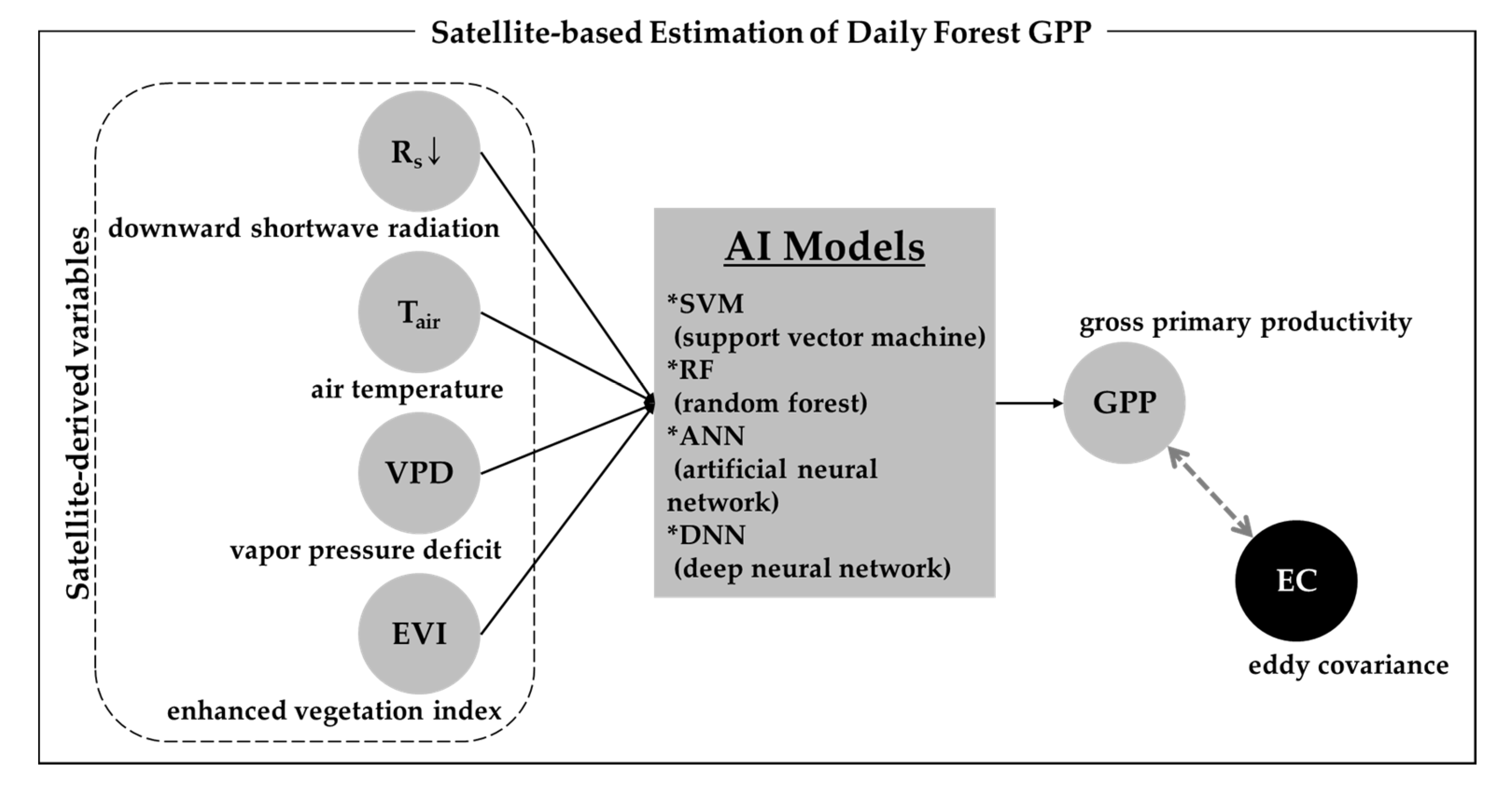
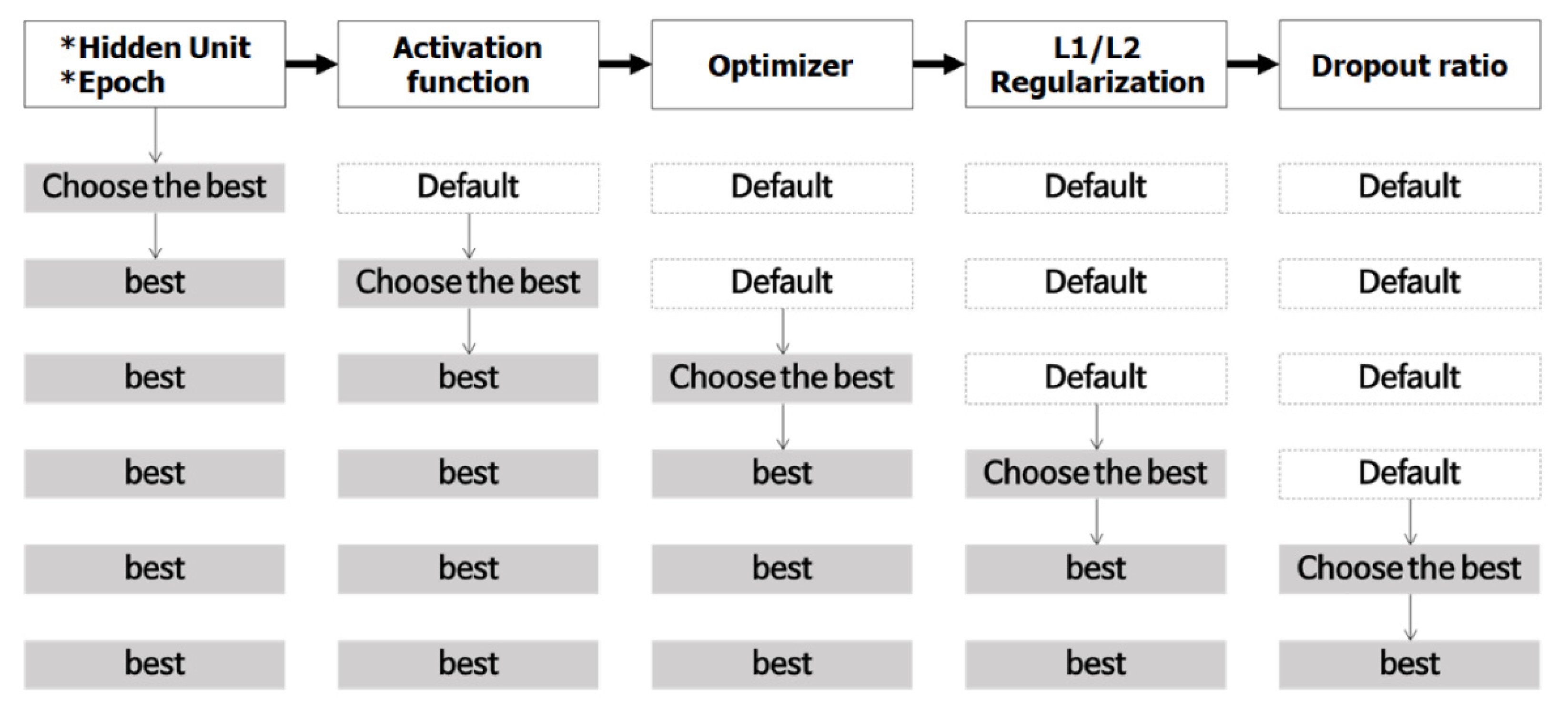
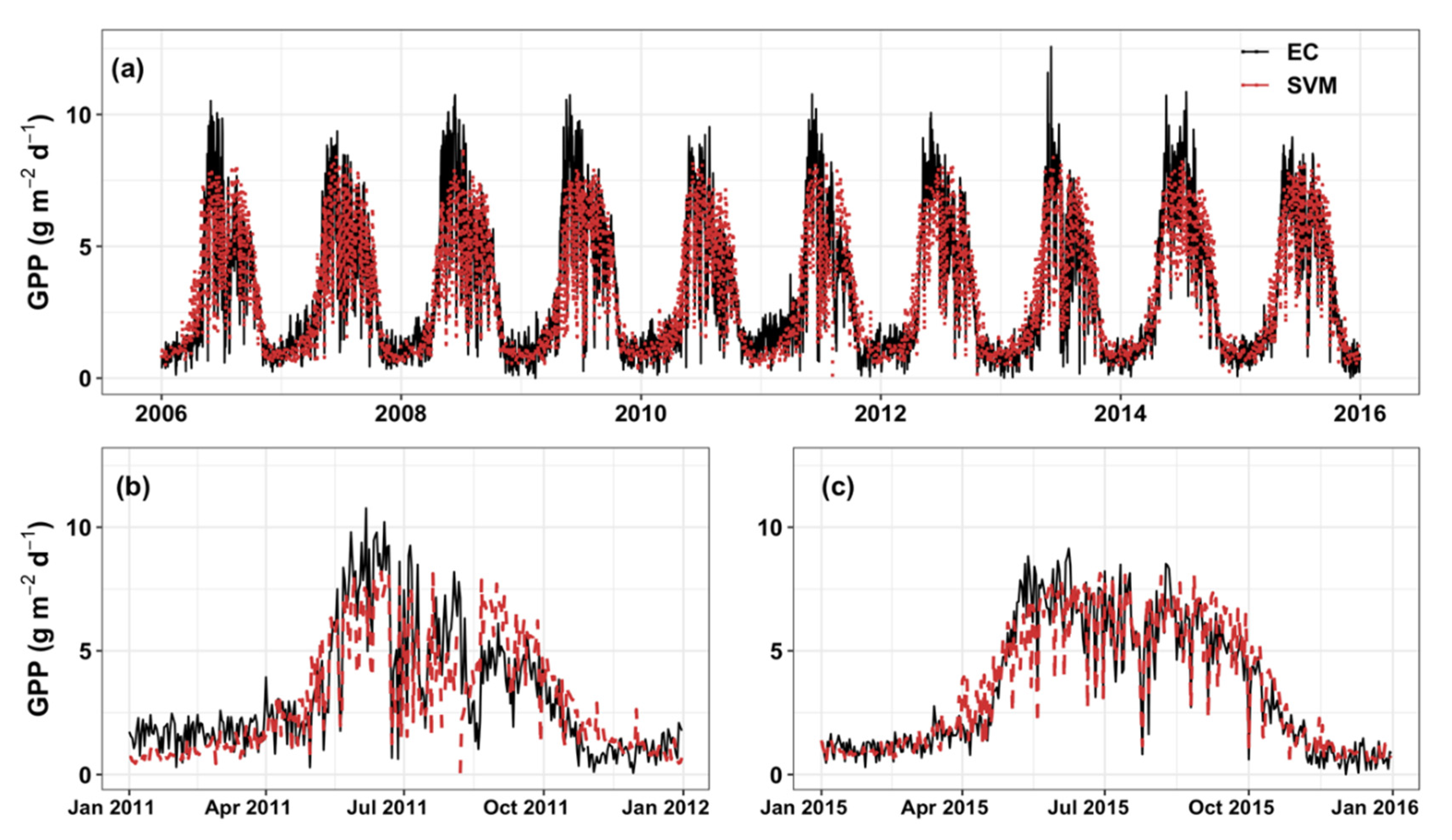
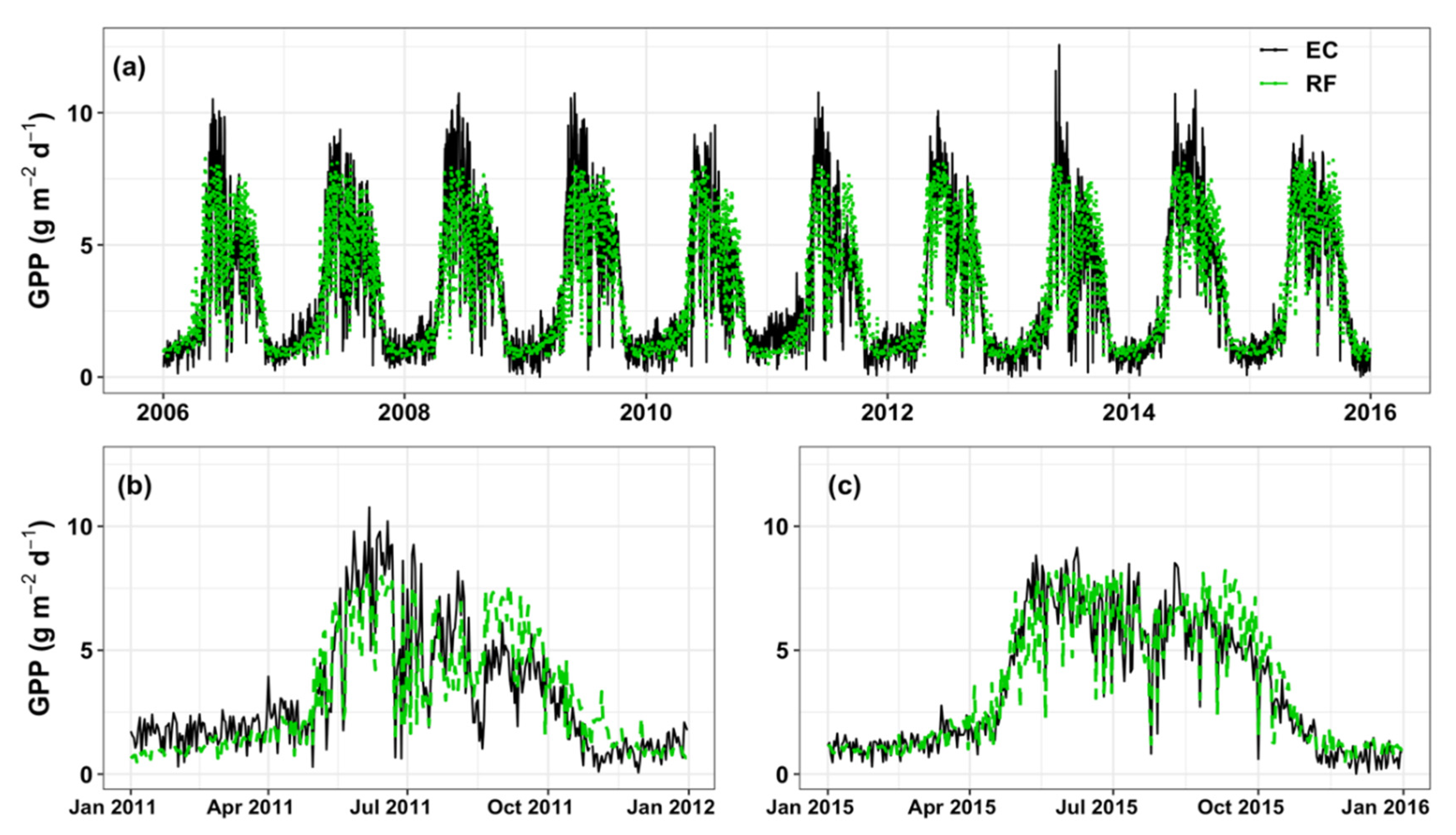
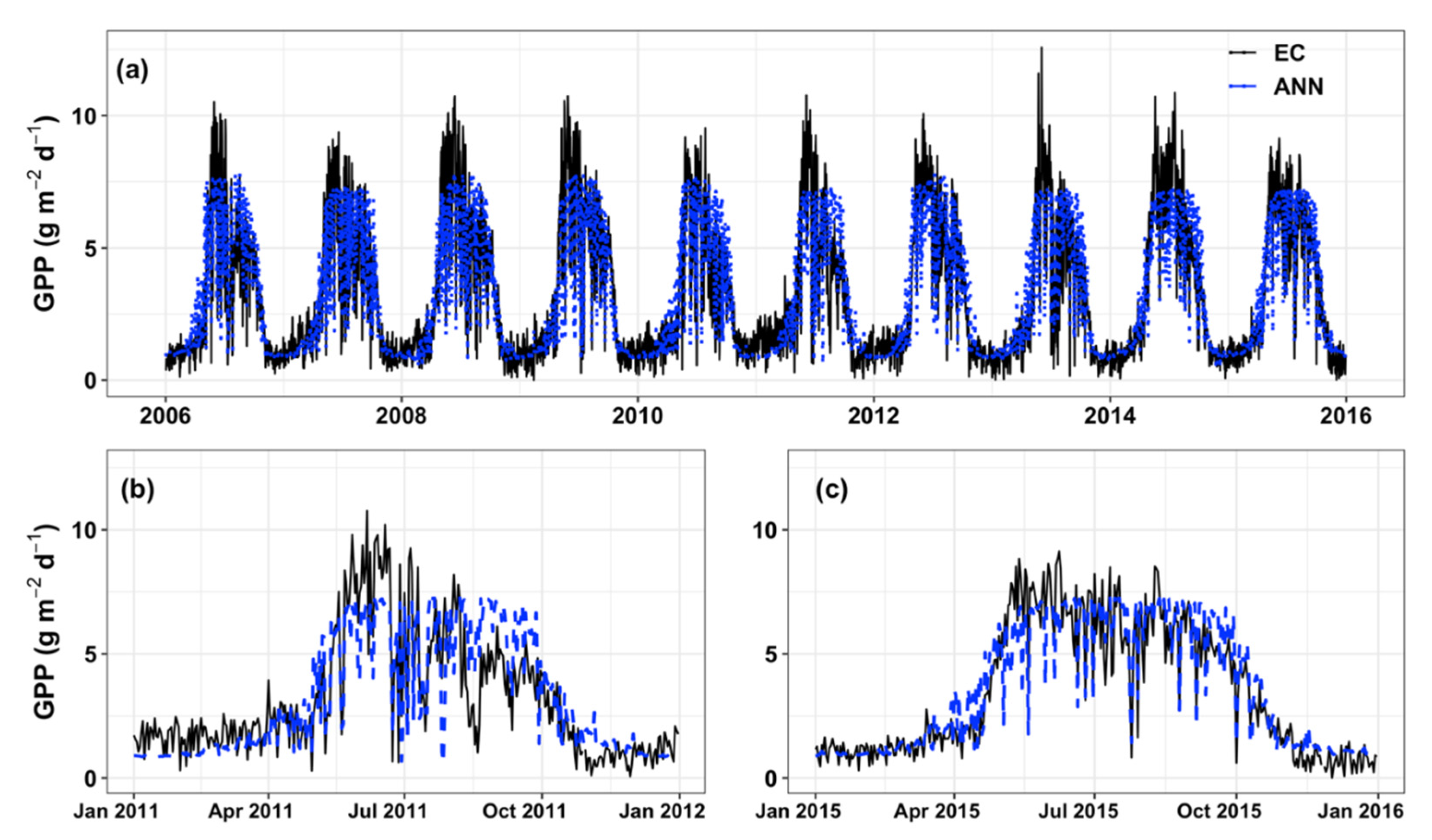


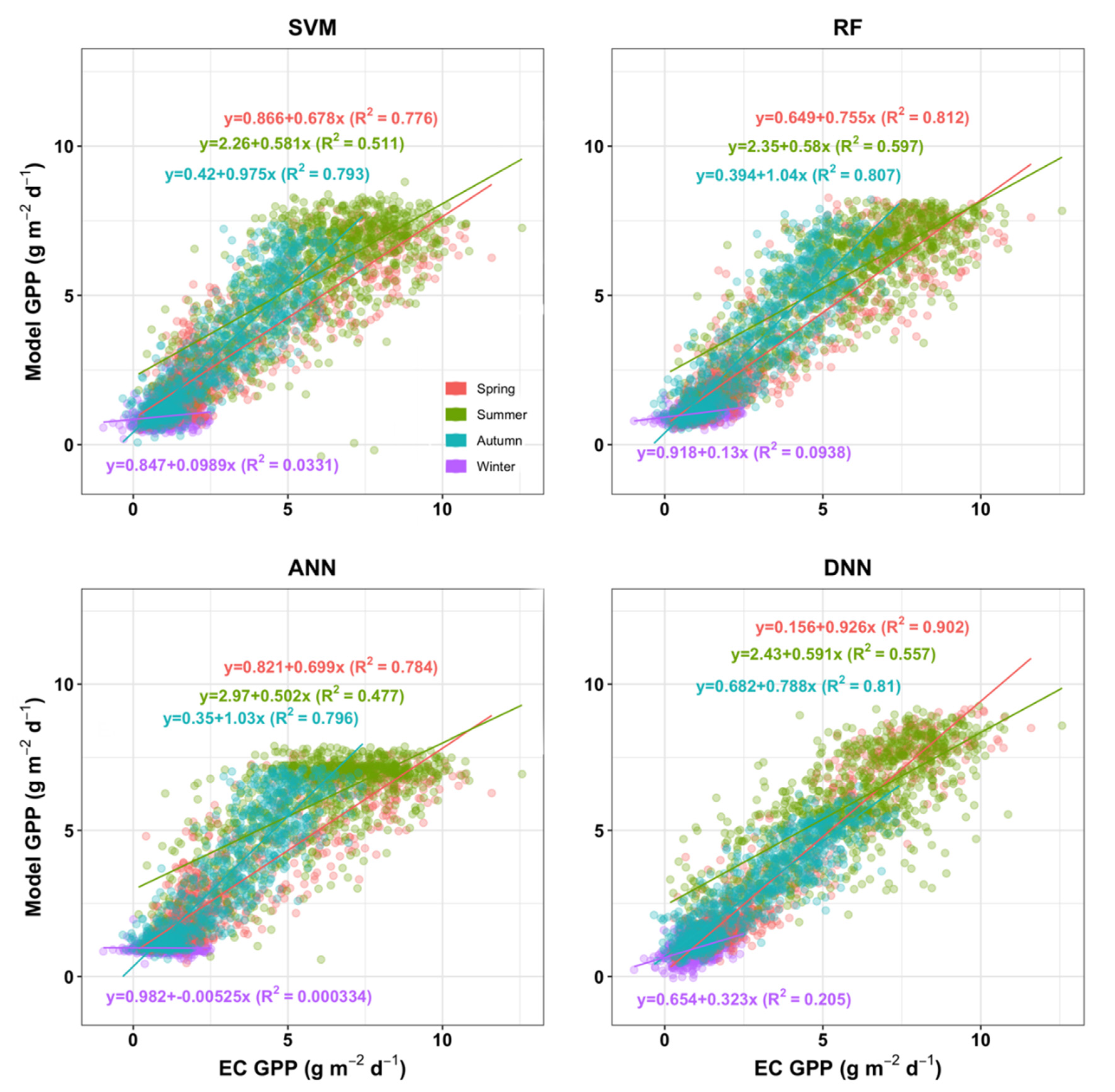
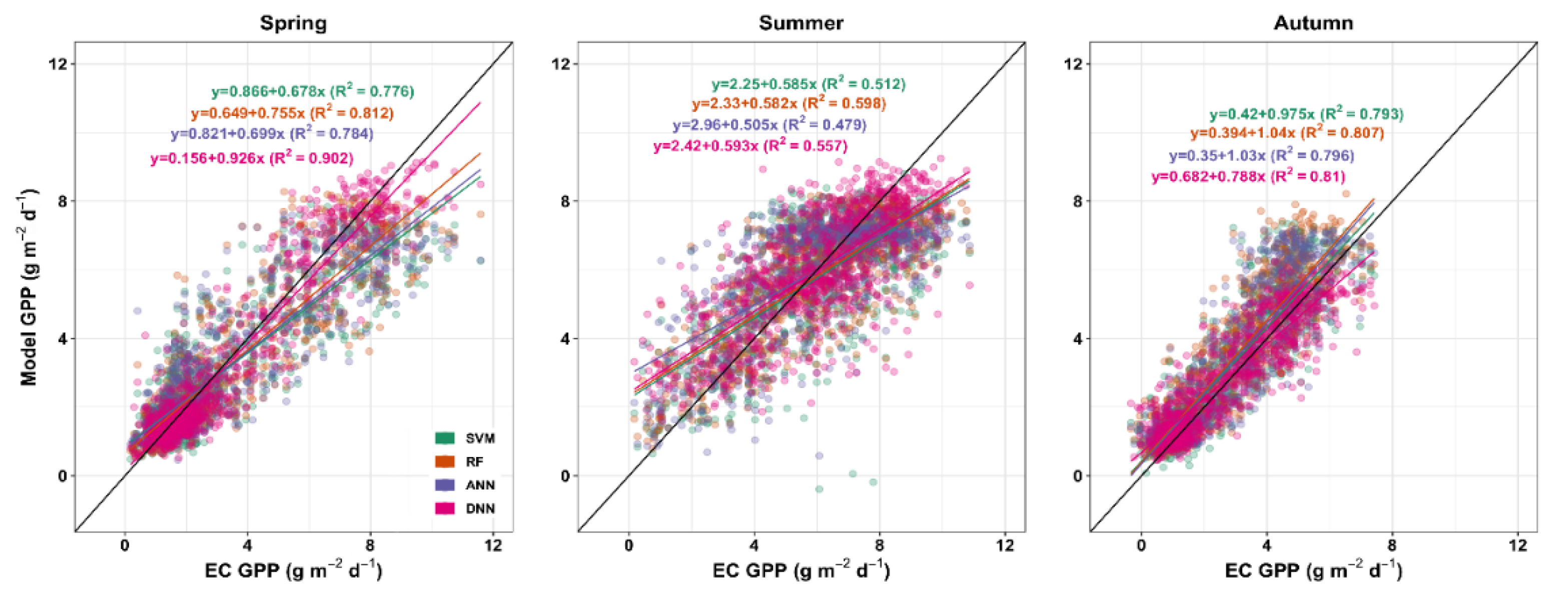
| MODIS Product | Data Extracted | Spatial Resolution | Temporal Compositing | Related Input Variable for This Study |
|---|---|---|---|---|
| MCD43B3 | Black- and white-sky albedo for shortwave radiation | 1 km | 16 days (1) | Rs↓ (3) |
| MYD04_L2 | Aerosol optical depth | 10 km | 1 day | Rs↓ |
| MYD05_L2 | Total column precipitable water | 5 km | 1 day | Rs↓ |
| MYD07_L2 | Air and dew-point temperatures, total ozone, and surface pressure | 5 km | 1 day | Rs↓, Tair (4), and VPD (5) |
| MOD13A2 (Terra) MYD13A2 (Aqua) | Enhanced vegetation index | 1 km | 8 days (2) | EVI (6) |
| Method | Min (1) (g m−2 d−1) | Max (2) (g m−2 d−1) | Mean (g m−2 d−1) |
|---|---|---|---|
| EC | 0.28 | 9.20 | 3.30 |
| SVM | 0.58 | 7.76 | 3.26 |
| RF | 0.74 | 7.83 | 3.35 |
| ANN | 0.85 | 7.49 | 3.35 |
| DNN | 0.55 | 8.49 | 3.29 |
| Year | Method | Min (1) (g m−2 d−1) | Max (2) (g m−2 d−1) | Mean (g m−2 d−1) |
|---|---|---|---|---|
| 2006 | EC | 0.42 | 9.68 | 3.10 |
| SVM | 0.64 | 7.69 | 3.27 | |
| RF | 0.73 | 7.70 | 3.34 | |
| ANN | 0.90 | 7.60 | 3.37 | |
| DNN | 0.74 | 8.15 | 3.27 | |
| 2007 | EC | 0.44 | 8.47 | 3.19 |
| SVM | 0.62 | 7.97 | 3.15 | |
| RF | 0.76 | 7.82 | 3.28 | |
| ANN | 0.91 | 7.22 | 3.25 | |
| DNN | 0.55 | 7.44 | 2.82 | |
| 2008 | EC | 0.32 | 9.76 | 3.65 |
| SVM | 0.65 | 7.55 | 3.33 | |
| RF | 0.76 | 7.71 | 3.40 | |
| ANN | 0.74 | 7.65 | 3.39 | |
| DNN | 1.04 | 8.85 | 3.77 | |
| 2009 | EC | 0.28 | 9.66 | 3.53 |
| SVM | 0.59 | 7.69 | 3.25 | |
| RF | 0.77 | 7.81 | 3.36 | |
| ANN | 0.87 | 7.60 | 3.28 | |
| DNN | 0.34 | 8.95 | 3.45 | |
| 2010 | EC | 0.41 | 8.55 | 2.98 |
| SVM | 0.56 | 7.74 | 3.11 | |
| RF | 0.71 | 7.73 | 3.16 | |
| ANN | 0.86 | 7.60 | 3.16 | |
| DNN | 0.59 | 8.30 | 2.95 | |
| 2011 | EC | 0.36 | 9.26 | 3.14 |
| SVM | 0.47 | 7.85 | 2.94 | |
| RF | 0.70 | 7.62 | 3.10 | |
| ANN | 0.85 | 7.22 | 3.20 | |
| DNN | 1.38 | 8.57 | 3.27 | |
| 2012 | EC | 0.26 | 8.51 | 3.35 |
| SVM | 0.60 | 7.70 | 3.24 | |
| RF | 0.77 | 7.83 | 3.39 | |
| ANN | 0.86 | 7.70 | 3.39 | |
| DNN | 0.32 | 8.50 | 3.32 | |
| 2013 | EC | −0.03 | 8.84 | 3.05 |
| SVM | 0.58 | 7.72 | 3.30 | |
| RF | 0.73 | 7.73 | 3.29 | |
| ANN | 0.83 | 7.20 | 3.37 | |
| DNN | 0.32 | 8.49 | 3.07 | |
| 2014 | EC | 0.33 | 9.35 | 3.56 |
| SVM | 0.57 | 7.70 | 3.43 | |
| RF | 0.77 | 7.89 | 3.53 | |
| ANN | 0.90 | 7.19 | 3.49 | |
| DNN | 0.65 | 8.04 | 3.51 | |
| 2015 | EC | 0.25 | 8.48 | 3.49 |
| SVM | 0.61 | 7.84 | 3.56 | |
| RF | 0.73 | 8.10 | 3.66 | |
| ANN | 0.92 | 7.22 | 3.62 | |
| DNN | 0.72 | 7.72 | 3.45 |
| Model | Year | MBE (1) (g m−2 d−1) | MAE (2) (g m−2 d−1) | RMSE (3) (g m−2 d−1) | CC (4) | Model | Year | MBE (g m−2 d−1) | MAE (g m−2 d−1) | RMSE (g m−2 d−1) | CC |
|---|---|---|---|---|---|---|---|---|---|---|---|
| SVM | 2006 | 0.17 | 0.87 | 1.24 | 0.88 | RF | 2006 | 0.25 | 0.80 | 1.14 | 0.90 |
| 2007 | −0.04 | 0.75 | 1.01 | 0.91 | 2007 | 0.09 | 0.71 | 0.96 | 0.92 | ||
| 2008 | −0.31 | 0.88 | 1.25 | 0.91 | 2008 | −0.25 | 0.81 | 1.17 | 0.92 | ||
| 2009 | −0.28 | 0.78 | 1.12 | 0.92 | 2009 | −0.17 | 0.73 | 1.04 | 0.93 | ||
| 2010 | 0.13 | 0.79 | 1.06 | 0.90 | 2010 | 0.18 | 0.77 | 1.08 | 0.90 | ||
| 2011 | −0.20 | 1.07 | 1.45 | 0.81 | 2011 | −0.04 | 0.97 | 1.26 | 0.86 | ||
| 2012 | −0.11 | 0.81 | 1.12 | 0.91 | 2012 | 0.04 | 0.69 | 0.97 | 0.93 | ||
| 2013 | 0.26 | 0.77 | 1.06 | 0.92 | 2013 | 0.24 | 0.69 | 0.96 | 0.94 | ||
| 2014 | −0.13 | 0.89 | 1.24 | 0.91 | 2014 | −0.03 | 0.85 | 1.21 | 0.91 | ||
| 2015 | 0.08 | 0.68 | 0.95 | 0.93 | 2015 | 0.17 | 0.68 | 0.95 | 0.94 | ||
| Avg. | −0.04 | 0.83 | 1.15 | 0.90 | Avg. | 0.05 | 0.77 | 1.07 | 0.92 | ||
| ANN | 2006 | 0.27 | 0.87 | 1.24 | 0.88 | DNN | 2006 | 0.18 | 0.70 | 1.02 | 0.92 |
| 2007 | 0.06 | 0.79 | 1.08 | 0.90 | 2007 | −0.37 | 0.75 | 1.03 | 0.92 | ||
| 2008 | −0.26 | 0.91 | 1.23 | 0.91 | 2008 | 0.12 | 0.71 | 0.97 | 0.94 | ||
| 2009 | −0.24 | 0.77 | 1.09 | 0.93 | 2009 | −0.07 | 0.67 | 0.95 | 0.94 | ||
| 2010 | 0.18 | 0.84 | 1.16 | 0.88 | 2010 | −0.03 | 0.67 | 0.94 | 0.92 | ||
| 2011 | 0.05 | 1.06 | 1.39 | 0.83 | 2011 | 0.13 | 0.77 | 1.05 | 0.90 | ||
| 2012 | 0.03 | 0.81 | 1.11 | 0.91 | 2012 | −0.03 | 0.68 | 0.92 | 0.94 | ||
| 2013 | 0.32 | 0.82 | 1.15 | 0.91 | 2013 | 0.02 | 0.58 | 0.87 | 0.94 | ||
| 2014 | −0.07 | 0.88 | 1.23 | 0.91 | 2014 | −0.05 | 0.66 | 0.97 | 0.94 | ||
| 2015 | 0.14 | 0.70 | 0.96 | 0.93 | 2015 | −0.04 | 0.63 | 0.90 | 0.94 | ||
| Avg. | 0.05 | 0.85 | 1.16 | 0.90 | Avg. | −0.01 | 0.68 | 0.96 | 0.93 |
| GPP Data | MBE (g m−2 d−1) | MAE (g m−2 d−1) | RMSE (g m−2 d−1) | CC |
|---|---|---|---|---|
| DNN | −0.014 | 0.405 | 0.537 | 0.975 |
| MODIS (Terra) | 0.224 | 0.998 | 1.278 | 0.916 |
| MODIS (Aqua) | 0.119 | 0.946 | 1.195 | 0.915 |
© 2020 by the authors. Licensee MDPI, Basel, Switzerland. This article is an open access article distributed under the terms and conditions of the Creative Commons Attribution (CC BY) license (http://creativecommons.org/licenses/by/4.0/).
Share and Cite
Lee, B.; Kim, N.; Kim, E.-S.; Jang, K.; Kang, M.; Lim, J.-H.; Cho, J.; Lee, Y. An Artificial Intelligence Approach to Predict Gross Primary Productivity in the Forests of South Korea Using Satellite Remote Sensing Data. Forests 2020, 11, 1000. https://doi.org/10.3390/f11091000
Lee B, Kim N, Kim E-S, Jang K, Kang M, Lim J-H, Cho J, Lee Y. An Artificial Intelligence Approach to Predict Gross Primary Productivity in the Forests of South Korea Using Satellite Remote Sensing Data. Forests. 2020; 11(9):1000. https://doi.org/10.3390/f11091000
Chicago/Turabian StyleLee, Bora, Nari Kim, Eun-Sook Kim, Keunchang Jang, Minseok Kang, Jong-Hwan Lim, Jaeil Cho, and Yangwon Lee. 2020. "An Artificial Intelligence Approach to Predict Gross Primary Productivity in the Forests of South Korea Using Satellite Remote Sensing Data" Forests 11, no. 9: 1000. https://doi.org/10.3390/f11091000
APA StyleLee, B., Kim, N., Kim, E.-S., Jang, K., Kang, M., Lim, J.-H., Cho, J., & Lee, Y. (2020). An Artificial Intelligence Approach to Predict Gross Primary Productivity in the Forests of South Korea Using Satellite Remote Sensing Data. Forests, 11(9), 1000. https://doi.org/10.3390/f11091000






